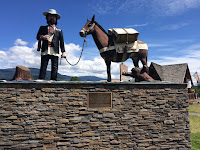Day 51 - Saturday July 8/17
A day of touring around the Hazeltons area- an area steeped in several thousands of years of “Gitxsan” (or Gitksan) and “Wet’su-wet’en” peoples’ occupation and history, as well as the much more recent European explorer and settler presence since the 1860’s (much later than their presence in Lower and Upper Canada, and even in the Prairies).
We were based in the “‘Ksan” campground, adjacent to the ‘Ksan Historical Village and Museum.
Our day started off slowly, as we took some time for a much-needed restful and restorative sleep-in! We had a light breakfast, and then put together the makings of beef stew in the crock-pot, to cook during the day. We then made up a picnic lunch, and headed out at about 11 am for touring in the region. Our first stop was at the Regional Visitors’ Centre, where we got some excellent information, maps, touring guides and directions! (photos)



There are several Gitxsan communities adjacent to and/or intermingled with the settler communities of “The Hazeltons” (Hazelton, New Hazelton and South Hazelton). We visited several of these communities, mostly in search of totem poles (some very old); as well, we followed, in part, the “Hand of History” self-guided automobile tour of the region. The area is known as the “Totem Pole Capital of the World”, with over 50 totem poles standing in 8 locations. (map and photos)

“The Hazeltons” were established, somewhat in ‘cpmpetition’ with each other, during the time of the completion of the Grand Trunk Pacific Railway, through the efforts of land speculators looking to make money by establishing rail station towns.
The Gitxsan peoples had lived in the region in well-established permanent communities for several millennia. They were able to live in their communities over long periods of time, as opposed to being nomadic peoples, as their primary food source was the salmon - which came to them up the many rivers and streams, rather than their having to travel to hunt for food.
The Gitxsan communities we visited included Gitanyow (aka Kitwancool) and Kitwanga/Gitwangak, on Hwy 37 (which runs north to Alaska - we will return here in a week or so to actually head ‘North to Alaska’ after our explorations of Prince Rupert and Haida Gwaii), and Kispiox, north of Hazelton on Hwy 49.
Our first major stop was Gitanyow (Kitwancool) to view totem poles, including a very famous “Hole-in-the-Ice” pole which dates to 1850 (photos). We had a nice chat with a woman who was selling hand-made jewellery there.



We then stopped at Kitwanga/Gitwangak, first to view the site of “Gatwangak/Battle Hill National Historic Site”, and then to view more totem poles.
The Battle Hill National Historic Site commemorates the site and exploits of a famous Gitxsan warrior Chief, ‘Nekt. (photos)


After viewing the site, we ate our picnic lunch there.
At Kitwanga/Gitwangak we also viewed more totem poles. (photos)

We then travelled to Kispiox, for a one further look at several totem poles. (photos)
After a full afternoon of touring/viewing, we returned to the ‘Ksan Campground, had a short nap, and then supper of the beef stew that had been cooking all afternoon in the crock-pot - mmmmmm, good!!
















The totem poles look like breathtaking works of art. I had no idea you could get such easy access to them. (It also occurs to me to wonder whether "totem" is an appropriate term for them--surely it's a white dudes' label, and may not reflect the true functions of the poles.)
ReplyDeleteHi Chris. Yes, it was fabulous to be able to get right up close and personal with these policies es, some more than 150 years old! Actually, 'totem' pole is probably quite accursate. The word comes from an Ojibwe word, 'doodem', meaning sacred symbols, objects or signs, and that is what they are, each owned by and representative of a clan.
DeleteOk, thanks--I'm amazed to learn this. I thought it was an anthropological term first applied to South Pacific cultures. What do I know??!
DeleteAnd I've just been reading and hearing more about the BC fires. Are you anywhere near the now?
ReplyDeleteWe were in that area just last week, but are now on the coast at Prince Rupert, considerably north and west. Very wet here. Nancy's family members we visited are right in the midst of the fires though. They are safe but had no power for three days, and are ready to leave at a moment's notice. Thanks for asking
DeleteI'm glad to know you're safe. So sad to think of the destruction and danger that is ongoing.
ReplyDelete